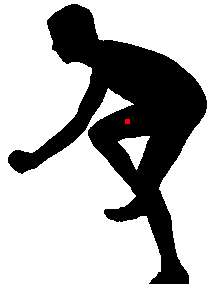estimating my moment of inertia
I was curious about my moment of inertia, as this is key to comparing the even and odd modes of vibration of the bike on the tires. So I found an old photo I took of myself on the trainer, traced out my body, and created an x-bitmap image, a format which is relatively easy to manipulate in C. I used my forearm length as a crude ruler.

Okay, I'm missing a bit of the foot, but don't sweat the details.
I calculated the "center of mass" in the image (I put a red dot there), then the mean of the square of the distance of pixels from the center. Okay, so this isn't quite right, as the "mass per pixel" isn't the same everywhere. But good enough for blogger work. The result was the square root of the mean square distance of pixels from the center-of-mass was 39.2 cm.
So there it is: 39.2 cm. Compare that with the half-wheelbase of my bike, which is 49.5 cm. This suggests that, neglecting the bicycle, the odd mode should be 60% higher in frequency than the even mode, at least if I did the calculation correctly.
Okay -- there's a big complication, and that is that vibrations don't necessarily move my entire body. Bodies act as damped spring-mass systems themselves. Kraig Willett gave me this fantastic link:

What really matters is the "unsprung" mass. The relevant mass may actually be more the bike mass than the full bike + body mass. Or the body mass gets deweighted, so to speak. Hmmm.... this is getting complicated.
More next time.

Okay, I'm missing a bit of the foot, but don't sweat the details.
I calculated the "center of mass" in the image (I put a red dot there), then the mean of the square of the distance of pixels from the center. Okay, so this isn't quite right, as the "mass per pixel" isn't the same everywhere. But good enough for blogger work. The result was the square root of the mean square distance of pixels from the center-of-mass was 39.2 cm.
So there it is: 39.2 cm. Compare that with the half-wheelbase of my bike, which is 49.5 cm. This suggests that, neglecting the bicycle, the odd mode should be 60% higher in frequency than the even mode, at least if I did the calculation correctly.
Okay -- there's a big complication, and that is that vibrations don't necessarily move my entire body. Bodies act as damped spring-mass systems themselves. Kraig Willett gave me this fantastic link:

What really matters is the "unsprung" mass. The relevant mass may actually be more the bike mass than the full bike + body mass. Or the body mass gets deweighted, so to speak. Hmmm.... this is getting complicated.
More next time.

Comments
This is a family blog.
thanks,
Dan
P.S. The direct measurement sounds clever. I think the principal error source is that the mass of peripheral pixels is likely a lot less tan that of central pixels, so I probably overestimate the moment.